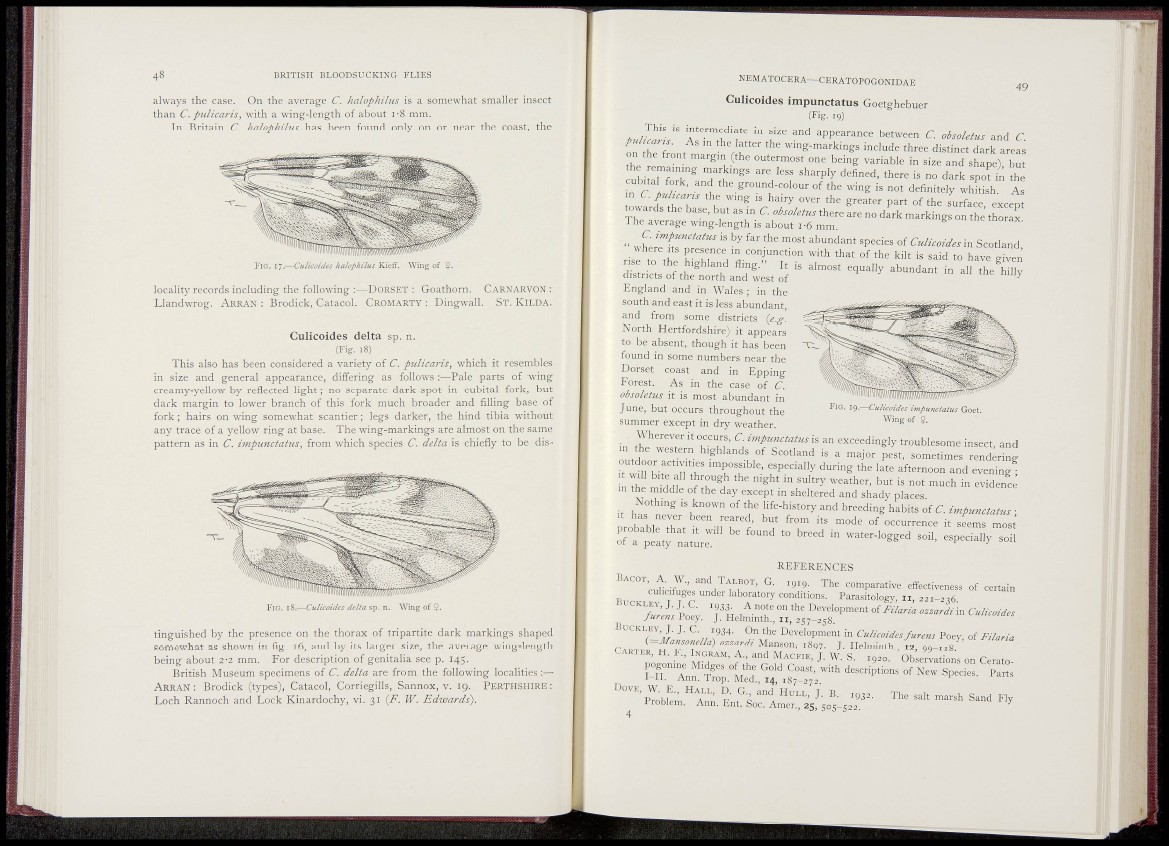
48 B R I T I S H BLOODSUCKING FLIES
always the case. On the average C. halophilus is a somewhat smaller insect
than C. pulicaris, with a wing-length of about i-8 mm.
In Britain C. halophilus has been found only on or near the coast, the
FIG. 17.—Culicoides halophilus'KieS. Wing of
locality records including the following : DORSET : Goathorn. CARNARVON :
L l a n d w r o g . ARRAN : B rodi ck, Catacol . CROMARTY : D ingwa l l . ST. KILDA.
Culicoides delta sp. n.
( F i g . 18)
This also has been considered a variety of C. pulicaris, which it resembles
in size and general appearance, differing as fohows :—Pale parts of wing
creamy-yellow by reflected light; no separate dark spot in cubital fork, but
dark margin to lower branch of this fork much broader and filling base of
fork; hairs on wing somewhat scantier ; legs darker, the hind tibia without
any trace of a yellow ring at base. The wing-markings are almost on the same
pattern as in C. impunctahis, from which species C. delta is chiefly to be dis -
FIG. 18.—Culicoides delta sp. n. Wing of
tinguished by the presence on the thorax of tripartite dark markings shaped
somewhat as shown in fig. 16, and by its larger size, the average wing-length
being about 2-2 mm. For description of genitalia see p. 145.
British Museum specimens of C. delta are from the following localities :—
A R R A N : Brodick (types), Catacol, Corriegills, Sannox, v. 19. PERTHSHIRE:
Loch Rannoch and Lock Kinardochy, vi. 31 {F. W. Edwards).
7 wm • B
M
N E M A T O C E R A - ^ C E R A T O P O G O N I D A E
49
Culicoides impunctatus Goetghebuer
( F i g . 19)
" f ' appearance between and C.
on Z f " . f w i n g - m a r k i n g s include three distinct dark areas
on the front margm (the outermost one being variable in size and shape) bu
u L t T f T ' Tti'"' ^ - - spo? ¿ the
m r i// 1 the ground-colour of the wing is not definitely whitish. As
n pu ^.ar^s the wmg is hairy over the greater part of the surface excep
towards the base, but as in there are no dirk markings on the t S Ix
1 he average wing-length is about i -6 mm
" w i ^ f t Z T ' " ' " ' ' - Scotland,
where its pre ence in conjunction with that of the kilt is said to have sriver^
nse to the highland fling." It is almost equally abundant in all the M y
districts of the north and west of ^
England and in Wales ; in the
south and east it is less abundant,
and from some districts (e.^.
North Hertfordshire) it appears
to be absent, though it has been
found in some numbers near the
Dorset coast and in Epping
Forest. As in the case of C.
obsoletus it is most abundant in
June, but occurs throughout the
FIG. 19.—Culicoides impunctatus Goet.
summer except in dry weather.
Wing of
m e r e v e r it occurs, C impunctatus is an exceedingly troublesome insect, and
m the western highlands of Scotland is a major pest, sometimes rend;ring
r w i l T b - t ^ ' T / r ^ T T ' ^ ' - u ^^^ ^^^^ ev ening !
nThe m in the miSdddll e off the day except in sheltered and shady p^l^a ces ^ ^ ^ in evidenc
it n 5e-history and breeding habits of C". ^n^punctatus ;
It has never been reared, but from its mode of occurrence it seems mos
oTa T A T R N I ; : : : " - — - p - i a n y : : ;
REFERENCES
''"'"'ci^^idf'^" The coinparative effectiveness of certain
B U C K : r f T F R ' conditions. Parasitology, 11, ..,-.36.
B U C K L E Y , J. J. C. 1934. On the Development in Culicoides furens Poey of F^laria
C a r t e r , H. P., INGRAM, A., and MACKIE, J. W. S. 19.0. Ob erLions on Cerato